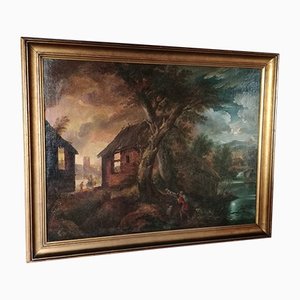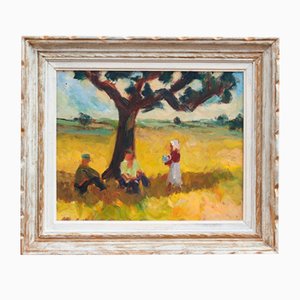Traducción generada automáticamente
Mostrar original
Mostrar traducción
Arthur Joseph Meadows.
English ( b.1843 - d.1907 ).
The Approaching Gale On The Scheldt Estuary, 1877.
Oil On Canvas.
Signed & Dated Lower Left.
Image size 17.3 inches x 31.5 inches ( 44cm x 80cm ).
Frame size 21.9 inches x 35.8 inches ( 55.5cm x 91cm ).
This original oil painting is by the coastal and marine artist Arthur Joseph Meadows and is dated 1877.
The painting is presented and supplied in a sympathetic and complimenting contemporary frame (which is shown in these photographs).
The painted surface has benefitted from some restoration, cleaning and conservation performed when in previous ownership in the last 10 years. The canvas was support lined during this restoration process.
This antique painting is in good condition, commensurate with its age. It wants for nothing and is supplied ready to hang and display.
The painting is signed and dated 1877 lower left.
Arthur Meadows was a successful nineteenth century English maritime artist. He was one of the most talented members of a family with a rich artistic heritage. His father James and his brother James Edwin were also respected artists, but Arthur is generally considered to be the best of them.
Arthur Meadows was born in Bow in the East End of London on 9 October 1843. He was the seventh of a large family of five sons and three daughters. As the youngest son he lived with his parents until his father’s death in 1863, and then continued to live in the neighbouring streets off Bow Road in close proximity to his mother and one of his sisters until 1868. from 1869 to the 1880s Arthur then lived with his family lived in Dover, where he was able to develop his sea painting. They lived there firstly at Charlton House, then at Eastbrook Terrace.
Arthur received most of his artistic training from his father. He became a follower of Clarkson Stanfield and developed a similar style. At the age of 18 he exhibited his first painting at The Royal Society of British Artists and between 1862-1885 a total of 22 of his works hung at The Royal Society. He also exhibited at the Royal Academy and at Suffolk Street.
At 21 Meadows married Laura Harrison, who was a seamstress and pianist. Meadows and his wife shared a love of music and he also played the violin and accordion. He was also an amateur dramatist (a member of drama group, The Pickwick Histrionic Club), a dancer and a keen sportsman. He and Laura raised at least eight children, so theirs was a most busy and creative household!
Meadows specialised in coastal and harbour scenes, some of England but often of the French or Dutch coast. He travelled extensively around Europe, including to France, Holland, Belgium, Germany and Italy. Towards the latter part of his career he produced some very impressive Venetian panoramas which are now much sought after.
His work compares very favourably with most of the major nineteenth century maritime artists, due to his impressive ability to convey the depth and movement of the sea and perfectly capture the atmosphere of a scene. He excelled in capturing local colour and detail within a subtle palette which gave his works a real emotional content.
Meadows made a good living from selling his art, generally direct to London dealers. He gifted works to many private individuals and other artists that he befriended. His financial success also enabled him to be active in early humanitarian efforts, and he was involved in the British and Foreign Anti-Slavery Society in the mid-Victorian era.
His oils are usually fully signed, whereas his watercolour works are generally initialled.
Meadows died on 17 November 1907 in Hammersmith, West London. Today Meadows’ paintings can be found in many museums and art galleries including The National Maritime Museum.
This original oil on canvas depicts a small sailing vessel, with a raised sail, skimming across the waves. This is a pilot boat, as denoted by the letter P on its sail. There is a larger vessel with two masts in the mid ground and a third large vessel in the background. Both of these are bathed in sunlight. This is all set in the Flemish North Sea coastline. On the shoreline we see a tall stone watch tower, with a row of modest dwellings along the shoreline. The sea is choppy with swell forming sea crests and challenging for all the vessels. The sky above is full of movement, with clouds in shades of grey and mauve. We anticipate the approaching gale which appears offshore.
Arthur Joseph Meadows.
Inglés ( n.1843 - d.1907 ).
The Approaching Gale On The Scheldt Estuary, 1877.
Óleo sobre lienzo.
Firmado y fechado abajo a la izquierda.
Tamaño de la imagen 17.3 inches x 31.5 inches ( 44cm x 80cm ).
Tamaño del marco 21.9 inches x 35.8 inches ( 55.5cm x 91cm ).
Este óleo original es obra del artista marino y costero Arthur Joseph Meadows y está fechado en 1877.
La pintura se presenta y se suministra en un marco contemporáneo simpático y complementario (que se muestra en estas fotografías).
La superficie pintada ha sido restaurada, limpiada y conservada durante los últimos 10 años. El lienzo fue forrado durante el proceso de restauración.
Este cuadro antiguo está en buen estado, acorde con su edad. No le falta de nada y se entrega listo para colgar y exponer.
El cuadro está firmado y fechado en 1877 en la parte inferior izquierda.
Arthur Meadows fue un exitoso artista marítimo inglés del siglo XIX. Fue uno de los miembros con más talento de una familia con una rica herencia artística. Su padre James y su hermano James Edwin eran también artistas respetados, pero Arthur está considerado generalmente como el mejor de ellos.
Arthur Meadows nació en Bow, en el East End de Londres, el 9 de octubre de 1843. Era el séptimo de una familia numerosa de cinco hijos y tres hijas. Como hijo menor, vivió con sus padres hasta la muerte de su padre en 1863, y después siguió viviendo en las calles vecinas de Bow Road, muy cerca de su madre y de una de sus hermanas, hasta 1868. Desde 1869 hasta la década de 1880, Arthur vivió con su familia en Dover, donde pudo desarrollar su pintura marina. Allí vivieron primero en Charlton House y después en Eastbrook Terrace.
Arthur recibió la mayor parte de su formación artística de su padre. Se convirtió en seguidor de Clarkson Stanfield y desarrolló un estilo similar. A los 18 años expuso su primer cuadro en la Royal Society of British Artists y, entre 1862 y 1885, un total de 22 obras suyas fueron expuestas en la Royal Society. También expuso en la Royal Academy y en Suffolk Street.
A los 21 años Meadows se casó con Laura Harrison, que era costurera y pianista. Meadows y su esposa compartían el amor por la música y él también tocaba el violín y el acordeón. También era dramaturgo aficionado (miembro del grupo de teatro The Pickwick Histrionic Club), bailarín y deportista entusiasta. Laura y él criaron al menos a ocho hijos, por lo que la suya fue una familia muy ocupada y creativa
Meadows se especializó en escenas costeras y portuarias, algunas de Inglaterra, pero a menudo de la costa francesa u holandesa. Viajó mucho por Europa, a Francia, Holanda, Bélgica, Alemania e Italia. Hacia el final de su carrera, realizó unos impresionantes panoramas venecianos que hoy en día son muy codiciados.
Su obra puede compararse muy favorablemente con la de la mayoría de los principales artistas marítimos del siglo XIX, debido a su impresionante capacidad para transmitir la profundidad y el movimiento del mar y captar perfectamente la atmósfera de una escena. Sobresalía en la captación del color local y el detalle dentro de una paleta sutil que dotaba a sus obras de un verdadero contenido emocional.
Meadows se ganaba bien la vida vendiendo sus obras, generalmente directamente a marchantes londinenses. Regaló obras a muchos particulares y a otros artistas con los que entabló amistad. Su éxito económico también le permitió participar activamente en los primeros esfuerzos humanitarios, y a mediados de la época victoriana formó parte de la British and Foreign Anti-Slavery Society.
Sus óleos suelen ir firmados, mientras que sus acuarelas suelen ir rubricadas.
Meadows murió el 17 de noviembre de 1907 en Hammersmith, al oeste de Londres. En la actualidad, los cuadros de Meadows se encuentran en muchos museos y galerías de arte, como el Museo Marítimo Nacional.
Este óleo sobre lienzo original representa un pequeño velero, con una vela izada, surcando las olas. Se trata de un barco piloto, como indica la letra P de su vela. En el centro, una embarcación más grande con dos mástiles y, al fondo, una tercera gran embarcación. Ambos están bañados por la luz del sol. Todo ello en la costa flamenca del Mar del Norte. En la orilla vemos una alta torre de vigilancia de piedra, con una hilera de modestas viviendas a lo largo de la costa. El mar está agitado y el oleaje forma crestas que suponen un desafío para todas las embarcaciones. El cielo está lleno de movimiento, con nubes en tonos grises y malvas. Anticipamos el vendaval que se avecina.
























Contacta con nosotros
Haz una oferta
¡Hemos notado que eres nuevo en Pamono!
Por favor, acepta los Términos y condiciones y nuestra Política de privacidad
Contacta con nosotros
Haz una oferta
¡Ya casi está!
Para seguir la conversación en la plataforma, por favor completa el registro. Para proceder con tu oferta en la plataforma, por favor completa el registro.Exitoso
Gracias por tu consulta, alguien de nuestro equipo se pondrá en contacto contigo en breve.
Si eres profesional del diseño, por favor solicita aquí los beneficios del Programa comercial de Pamono